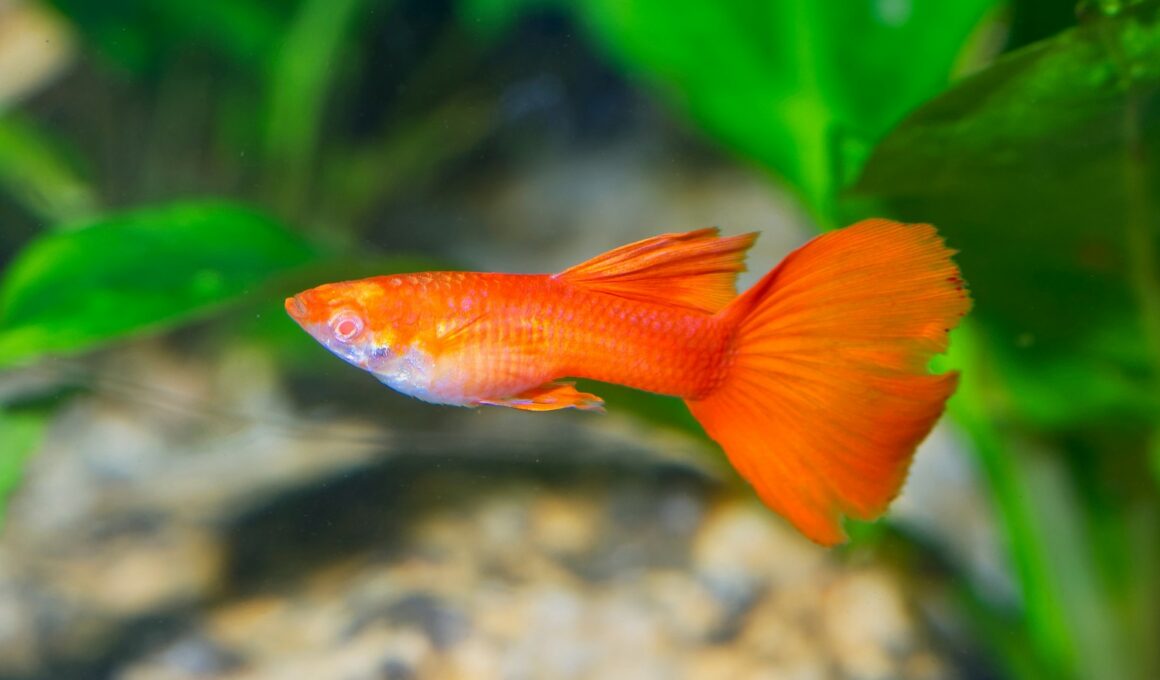In this article Show
Guppies are a staple in the home aquarium hobby and for good reasons. These small, vibrant fish bring life and color to any tank, making them a favorite among beginners and seasoned aquarists alike.
Having kept fish for years, I can attest to the sheer joy these little swimmers bring, but with that joy comes responsibility. You see, while guppies are often touted as easy to care for, ensuring they thrive requires a bit more than just filling a tank with water.
Like any other pet, they have specific needs. And today, we’re diving deep (pun intended) into the world of guppy care. So, whether you’re just setting up your first tank or looking to refine your guppy-keeping skills, let’s embark on this journey together.
Understanding the Guppy Fish
Guppies, scientifically known as Poecilia reticulata, are more than just pretty faces in our aquariums. To truly appreciate them and cater to their needs, it’s helpful to dive a bit into their background.
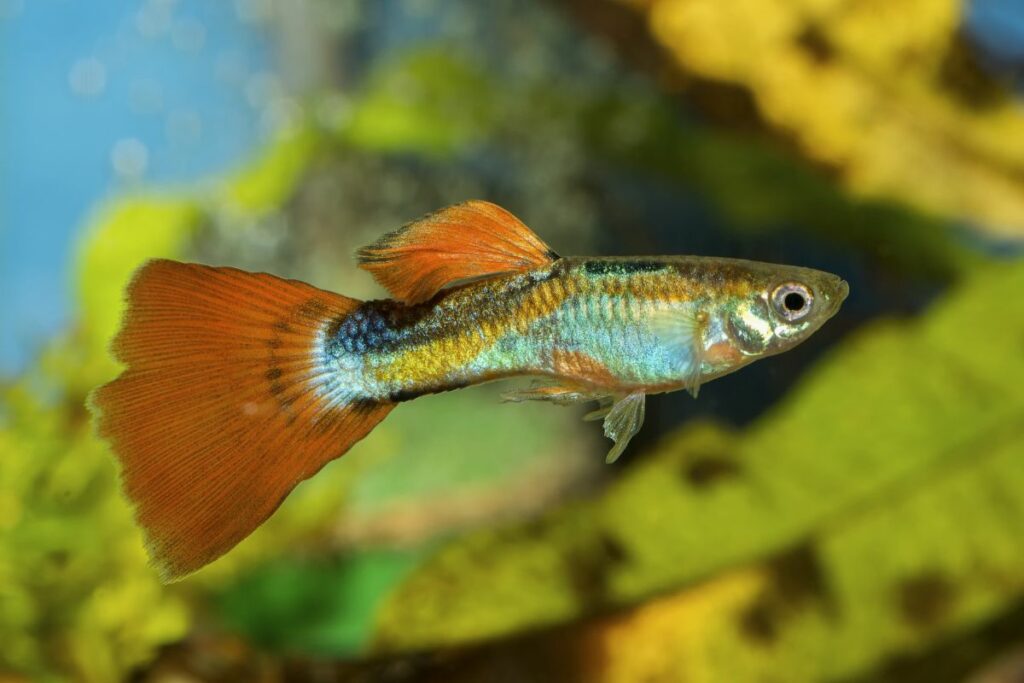
1. Origin and Natural Habitat
Hailing from the freshwater streams and rivers of South America, particularly in areas like Venezuela, Trinidad, and Barbados, guppies have evolved in diverse environments, from clear waters to brackish regions. In their natural habitat, they love to hover around plants, nibbling on tiny organisms and swimming in gentle currents.
2. Physical Characteristics
A typical guppy will grow to around 1.5 to 2.5 inches, with males generally being smaller than females. The color varieties are where guppies truly shine!
From dazzling neon blues to fiery reds and intricate patterns, guppy varieties are abundant. Their tail fin, also known as the caudal fin, can come in various shapes like fan, sword, or lyretail, making them a visual delight.
3. Behavior and Temperament
Guppies are peaceful by nature, often seen swimming around the middle layers of an aquarium. They’re social fish, preferring the company of their kind. A characteristic trait of guppies is their inquisitive nature. It’s not uncommon to see them exploring every nook and cranny of a tank or even following your finger around the glass.
Tank Setup For Guppies
Setting up a tank for guppies isn’t just about aesthetics; it’s about creating an environment where these tiny wonders can thrive. Drawing from my own experiences and the guppies’ natural habitat, here’s how to get started:
1. Ideal Tank Size
- Minimum Tank Size: A group of 3 to 5 guppies would be comfortable in a 10-gallon tank. However, if you’re planning on a community tank or breeding, consider going larger.
- Space Considerations: For larger groups, a good rule of thumb is to add an extra gallon for every new guppy. This ensures they have ample space to swim, explore, and avoid territorial disputes.
2. Water Parameters
- Temperature: Guppies prefer warm waters. Maintain a consistent temperature between 74°F to 82°F.
- pH Level: A neutral to slightly alkaline pH level of 6.8 to 7.8 is ideal.
- Hardness: Aim for a general hardness (GH) between 8-12 dGH and a carbonate hardness (KH) of 6-8 dKH.
3. Filtration and Aeration
- Best Types of Filters: Sponge filters work great for guppies as they provide gentle flow and won’t suck up the tiny fry. Hang-on-back (HOB) filters can also be used, but make sure the flow isn’t too strong.
- Water Circulation: A gentle flow mimics their natural habitat. It’s vital for distributing heat, and oxygen, and filtering out impurities.
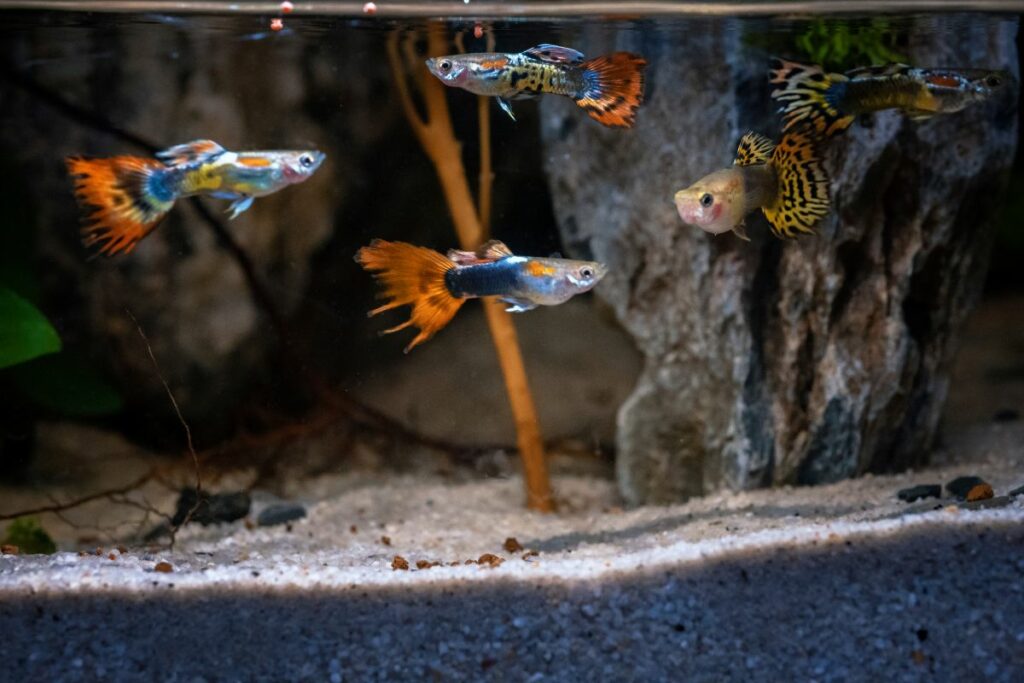
4. Substrate and Decoration
- Recommended Substrate: Fine-grained sand or small pebbles are both suitable. They are soft on the guppies’ delicate bodies and don’t trap debris easily.
- Plants and Decor: Since guppies love plant-dense environments, consider adding live aquatic plants like Java moss, Hornwort, or Anubias.
These not only provide hiding spots but also contribute to a balanced ecosystem. In addition to plants, consider adding caves or driftwood, ensuring they have no sharp edges that might injure the fish.
When setting up a tank for guppies, the aim is to strike a balance between functionality and aesthetics. By keeping their natural habitat in mind and ensuring the basics are in place, you’re setting the stage for a vibrant, healthy aquarium.
Diet and Feeding
Feeding guppies can be a delightful part of the fish-keeping experience. Watching them dart around, eagerly chasing after food particles is a sight to behold. But what, when, and how much to feed them? Let’s break it down.
1. Nutritional Needs of Guppy Fish
Guppies are omnivores, meaning they thrive on a mix of both plant-based and animal-based foods. In the wild, their diet consists of algae, small invertebrates, and insect larvae.
2. Best Types of Commercial Foods
- Flakes: A high-quality tropical fish flake food is a staple for guppies. Ensure it’s rich in proteins and vitamins for optimal health.
- Pellets: While guppies can eat micro pellets, they should be fed in moderation and supplemented with other foods.
- Granules: Slow-sinking granules can be a good alternative to flakes, ensuring even the shyer guppies get their share.
3. Benefits of a Varied Diet
- Live Foods: Brine shrimp, daphnia, and bloodworms are fantastic treats. They not only provide essential proteins but also stimulate the guppies’ natural hunting instincts.
- Frozen Foods: If you’re not keen on live foods, frozen varieties of the aforementioned options are widely available and just as nutritious.
- Vegetables: Blanched veggies like zucchini, lettuce, and cucumber can be introduced occasionally. They provide essential fibers and minerals.
4. Feeding Frequency and Portion Size
- How Often: It’s best to feed guppies once or twice a day.
- How Much: Offer only what they can consume in 2-3 minutes. Overfeeding can lead to water quality issues and obesity.
- Observation is Key: Notice their eating habits. If you find leftovers after feeding, consider reducing the portion next time.
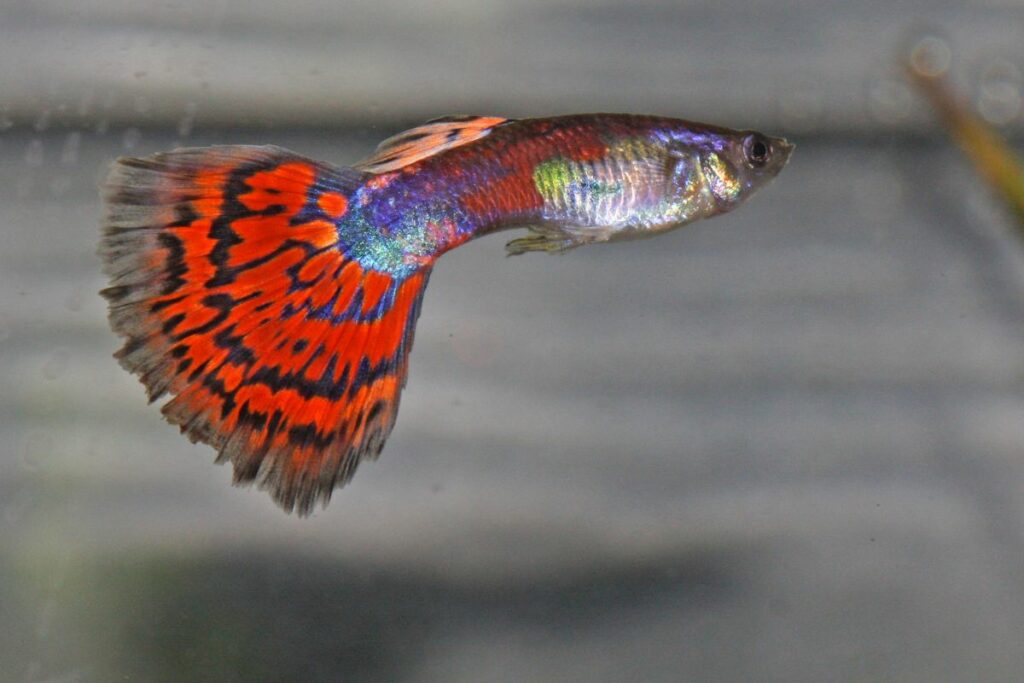
Guppy Fish Lifespan and Health
A shimmering guppy, gracefully gliding through the tank, is a testament to both its genetics and the care it receives.
And while guppies might seem hardy—and they often are—understanding their typical lifespan and potential health issues can ensure they stay robust and vibrant for as long as possible.
1. Average Lifespan of a Guppy in Captivity
Guppies usually live between 1 to 3 years in a well-maintained home aquarium. While this might not seem very long, with proper care, it’s not uncommon for some guppies to exceed this average. Their lifespan is influenced by factors like genetics, diet, water quality, and stress levels.
2. Common Health Issues and Their Prevention
- Fin Rot: This is characterized by frayed or disintegrating fins. Keeping the water clean and treating it with the appropriate medication can combat this condition.
- Ich (White Spot Disease): Look for tiny white spots on their body and fins. Raising the tank temperature slightly and using an anti-ich medication can help.
- Internal Parasites: Signs include weight loss and stringy white feces. Specialized treatments and medicated foods can target these pests.
- Swim Bladder Disease: A guppy struggling to maintain its buoyancy might be suffering from this. Often, dietary adjustments can alleviate the issue.
3. Importance of Quarantine for New Fish
One of the most effective ways to prevent diseases is by quarantining new arrivals. Before introducing new guppies or other fish into your main tank, it’s advisable to keep them in a separate quarantine tank for 2-4 weeks.
This period allows you to observe them for any signs of disease or parasites, ensuring your main tank remains a healthy environment.
Breeding Guppies
Breeding guppies is both an art and a science, offering an exciting endeavor for aquarists. Their prolific nature, coupled with the stunning array of colors and patterns they can produce, makes the experience deeply rewarding.
If you’re looking to venture into the world of guppy breeding, here’s a guide to set you on the right path.
1. Basic Understanding of Guppy Reproduction
Guppies are livebearers, which means they give birth to live young instead of laying eggs. A unique aspect is the presence of a specialized fin in males called the gonopodium, used to transfer sperm to the female.
Once a female guppy is fertilized, she can store the sperm and produce several batches of fry over the coming months, even without the presence of a male.
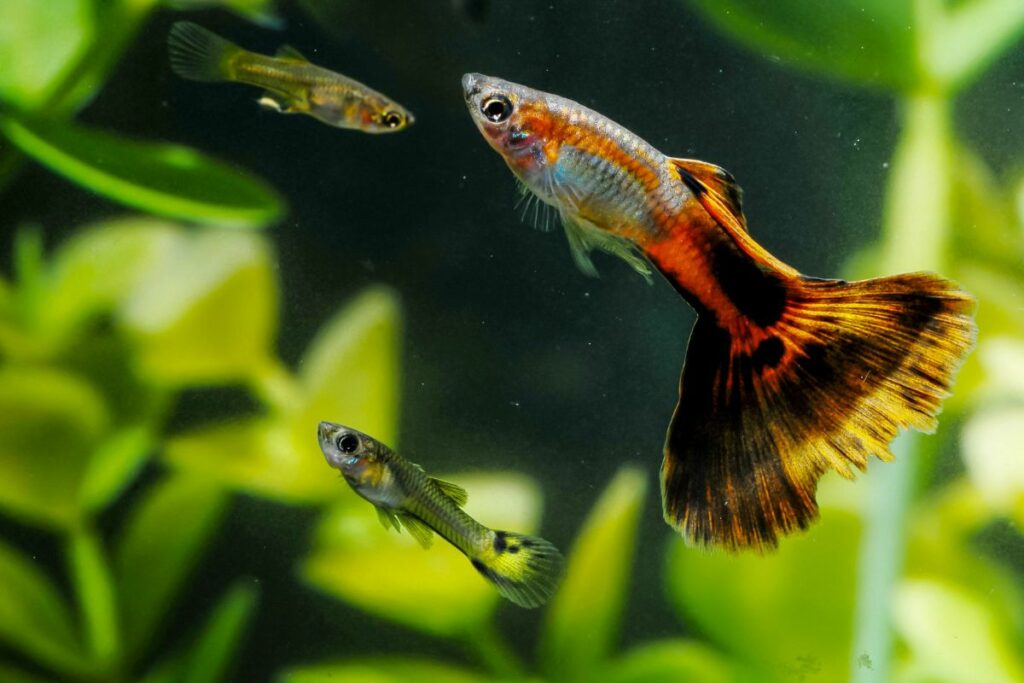
2. Setting Up a Breeding Tank
- Size: A 10-gallon tank works well for breeding purposes.
- Water Parameters: Keep the conditions similar to the main tank—temperature between 74°F to 82°F, and pH levels between 6.8 to 7.8.
- Hideouts: Adding plants like Java moss or breeding mops provides refuge for fry, reducing the risk of them being eaten by adults.
- Filter: A sponge filter is ideal as it won’t suck up tiny fry and provides gentle aeration.
3. Care for Fry and Juvenile Guppies
- Initial Care: Fry are tiny and can be vulnerable. If you’re keeping them in the same tank as adults, ensure ample hiding spots.
- Feeding: Newly hatched brine shrimp (Artemia nauplii) is a fantastic first food. Crushed flakes or specialized fry food can also be introduced as they grow.
- Growth and Separation: As the fry grow and start showing their colors, consider separating males from females to control breeding and avoid inbreeding.
4. Breeding for Specific Traits
For those looking to breed guppies for specific colors or tail types, selective breeding is key. This involves choosing specific males and females with desired traits and breeding them. It’s a longer-term commitment but can yield stunning results.
Frequently Asked Questions
Can guppies live with other fish?
Absolutely. Guppies are generally peaceful and can coexist with many other community fish. Ideal tank mates include tetras, mollies, and platies. However, it’s essential to avoid keeping them with larger, aggressive fish that might see guppies as a snack.
How often should I change the tank water?
Regular water changes are vital for a healthy aquarium. For guppies, changing 25% of the tank water every 2 weeks is a good practice. However, if the tank is densely populated or you notice water quality issues, weekly changes might be necessary.
What are the signs of a sick guppy?
Sick guppies might exhibit various symptoms. Clamped fins, erratic swimming, loss of appetite, fading colors, white spots, or any visible growths are all signs to watch out for. If a guppy shows any of these symptoms, it’s essential to diagnose the issue and treat it promptly.
Conclusion
Embarking on the journey of guppy care is both rewarding and enlightening. These vibrant, active swimmers don’t just add beauty to our homes but also teach us the nuances of a balanced aquatic environment.
By understanding their needs, from tank setup to diet and health, we not only ensure their well-being but also get to witness the sheer joy of a thriving aquarium.
Whether you’re a beginner or an experienced aquarist, remember: that every ripple in the water, every shimmer of their tails, is a testament to the care and love you provide.






